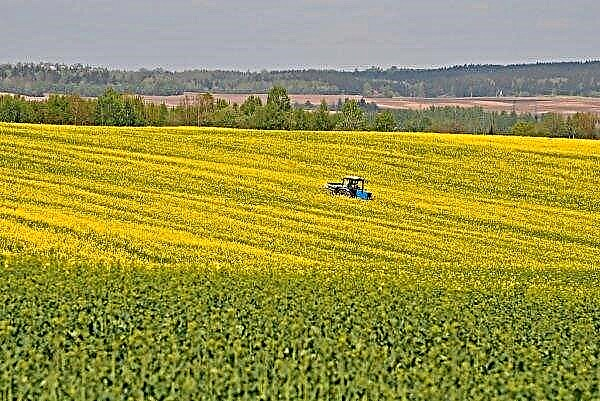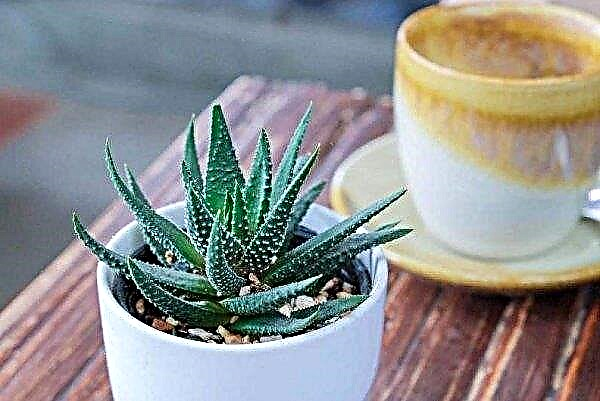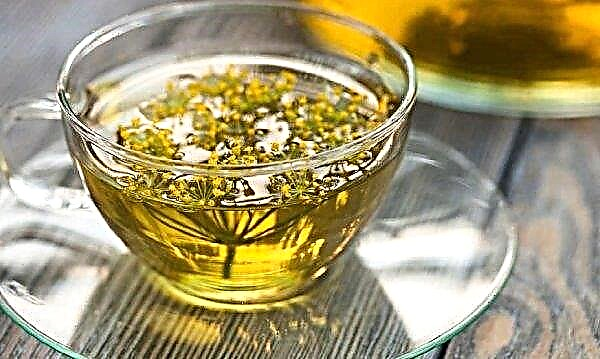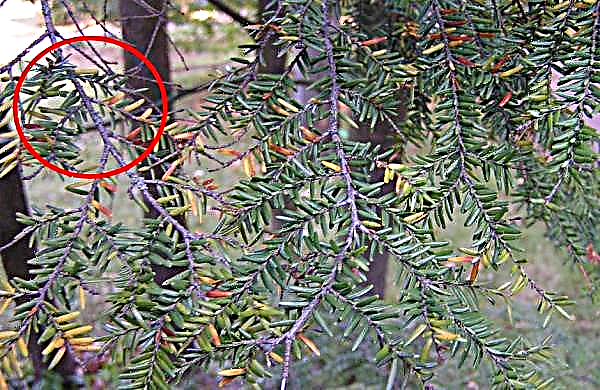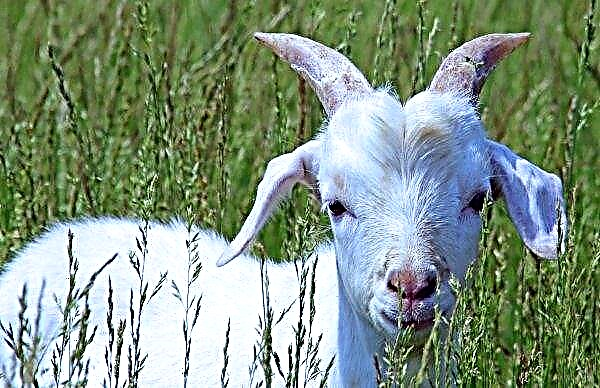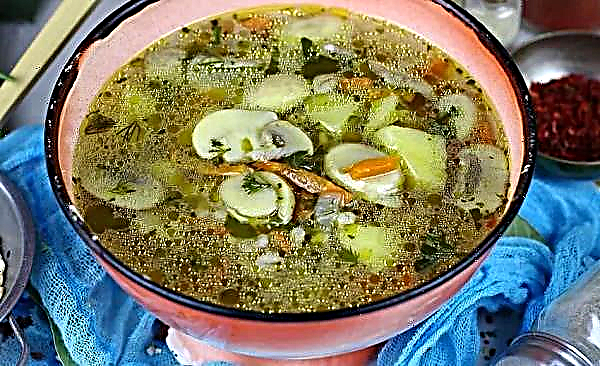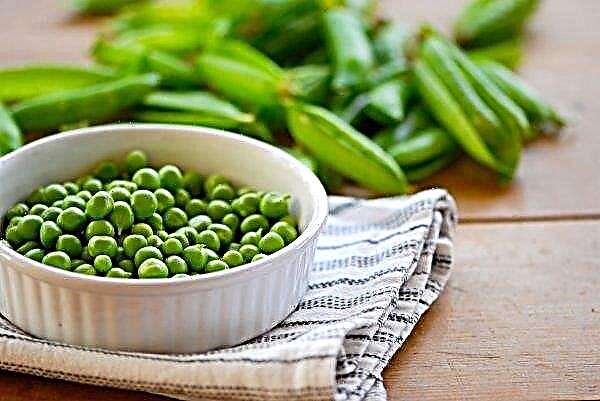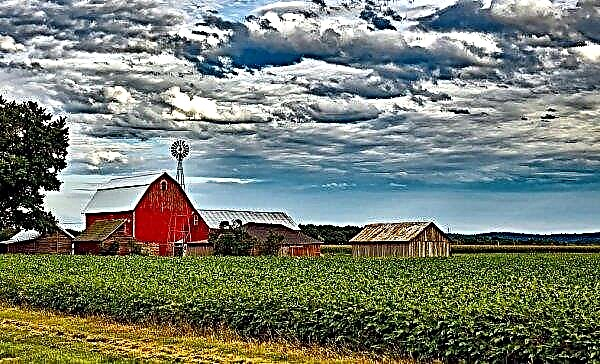One type of green onion, which combines the beneficial properties and ease of cultivation, is chives. The plant gives a generous harvest of fragrant and juicy greens, and its decorative appearance decorates the site. In this article, we will consider the description of chives, list the known varieties of this plant, the features of its planting and cultivation, methods of reproduction, as well as methods of combating possible diseases and pests.
Plant description
Other names for chives - speed, chisel, sibulet, may be the outdated name "snitch". This perennial vegetable crop grows in the Northern Hemisphere, in Central Asia and even on the shores of the Arctic Ocean.
Did you know? Schnitt onions were grown in ancient Greece, but only as a honey culture, the pleasant aroma of which attracts bees to the site.
Consider a botanical description of a plant:
- The root system of the pan is branched and covers a large volume of soil. The roots are filiform. Every summer, new roots form, and the old die off.
- The height of the false stem can reach 10 cm. It usually has from 4 to 6 leaves.
- The leaves are small, thin and tubular, with a diameter of about 0.8 cm. They are painted in dark green and have a spicy taste. The length of the green part is up to 25 cm.
- The lower part of the plant is a false bulb with a diameter of about 1 cm, covered with brown scales. Bulbs have a white juicy pulp, and their diameter is 0.8 cm.
- Rezan blooms the next year after planting seeds, starting in May. The flowering period lasts all summer. Inflorescences have a semicircular shape and consist of small purple umbrellas. Peduncle height can reach 40 cm.
- After flowering is completed, a fruit in the form of a box is formed. Inside it there are small rounded seeds that fully ripen in late July or early August and turn black.
- The first harvest of greens is recommended to be collected in the second year after planting. Productivity in this period reaches 15 t / ha, and in the third year of cultivation - up to 30 t / ha.
- The plant is resistant to cold, young shoots can withstand frosts down to –4 ° С.
- Chives are used to make fresh salads, savory and savory snacks, and also as a decorative plant.

Varieties of chives
To date, there are many varieties of chives. They differ from each other in terms of crop ripening, the color of inflorescences and the length of the leaves, and also exhibit varying degrees of resistance to diseases and pests.
Important! All varieties of chives have the same requirements for growing conditions and care.
A list of the most popular varieties for growing and a brief description are presented below:
- Albion. The variety has dark green leaves covered with a waxy coating. It has a sharp taste and pleasant aroma of leaves.
- Bohemia. Dark green leaves reach about 50 cm. The yield of the variety is high, and the taste of greenery is semi-sharp. Plants are almost not affected by diseases and pests.

- Vitamin Sheaf. Plants of this variety are a branched bush with leaves, the length of which reaches 45 cm. The yield of the variety for the season is about 2 kg / 1 m².

- Spring of the North. Greens ripen within 40 days after emergence, and its length can reach 45 cm. The plant looks like a lush bush, so it gives a high yield of feather.

- Grass. The variety has bright green leaves, whose length is 40–45 cm. The crop ripens early, in one cut from the bush you can collect up to 20 g of succulent greenery.

- Green ray. Belongs to early ripening varieties with the longest greens - up to 50 cm. The average yield from 1 m² is about 2 kg per season.

- Crocus. The plant is moderately branched, with a small elongated bulb. The first greens are cut off 25 days after emergence. The leaves are dark green, with good taste.

- Honey plant. The plant has a lush green mass, which quickly grows after cutting. The bulb is very weakly expressed, and the length of the leaves can reach 40 cm. The leaves have a dark green color and a semi-sharp taste.
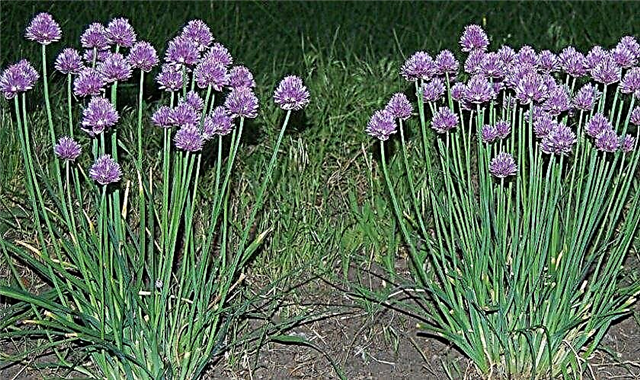
- Prague. The variety is early ripe and has lush dark green leaves. Their taste is notable for its pungency and lack of unpleasant bitterness.
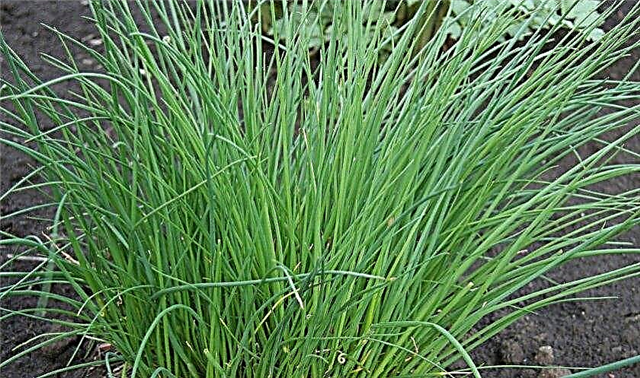
- Siberian. The variety is characterized by the presence of particularly lush light green leaves, the height of which can reach 60 cm. This type of onion is very resistant to low air temperatures.

- Old. An early ripe variety that gives a record harvest of fresh herbs - up to 5.5 kg / 1 m². The length of bright green leaves is about 40 cm.

- Chemal. The variety has long (up to 50 cm) leaves and is characterized by a sharp taste. The immunity of the plant is not as stable as in other varieties, so the bushes are often affected by powdery mildew.

- Khibiny. This variety can be grown on the site for 7 years, while its greens remain tender and tasty. The green part of the plants is tall and lush, and the inflorescences consist of bright purple flowers.
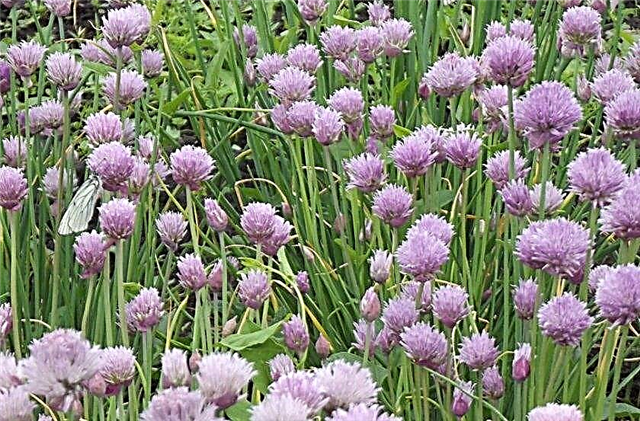
- Elvi. Decorative variety, used to decorate paths on the site or home growing in a pot, but can also be used to produce greenery. Inflorescences have a bright white color.

Outdoor landing
The seeds of chives are much smaller than onions, and have poor germination. Therefore, you need to properly prepare them for planting, as well as choose a suitable place for onions on the site and prepare the soil. The process of sowing seeds does not require special skills, but should be carried out only at certain times. Consider all the features of planting chives in open ground and find out whether it can be sown for the winter.
Important! After cutting the chives, it retains all its beneficial properties only for 15–20 minutes, but can remain tasty for a day.
Optimal timing
So that the planted material sprouts as soon as possible, you need to plant at the appropriate time. Chives are cold-resistant varieties, but if you plant the seeds at the wrong time, they may not sprout. The main dates for planting a chisel are listed below:
The main dates for planting a chisel are listed below:
- spring sowing of seeds in open ground is carried out in late April or in the first half of May;
- the parts separated from the mother bushes can be planted in spring, at the end of March or in April, and in autumn, in September;
- sowing seeds of chives in winter is better in late September or early October - in open ground or in containers for growing indoors.
Site selection and soil preparation
This type of onion is well adapted to various climatic conditions, but the quantity and quality of the crop directly depends on the correct choice of place for planting the crop.
Consider the list of requirements for the site for growing pans:
- the site should be in partial shade, so that the leaves of the onion do not suffer from direct sunlight;
- the soil on the site should not quickly evaporate moisture, plants constantly need moist soil;
- for planting a chisel, you can use the free space along the paths between the beds, forming living borders from flowering plants;
- it is recommended to choose a plot for growing on which cucumbers, tomatoes, potatoes, greens or radishes grew last year;
- chives cannot be planted in the area where legumes, beets or cabbage grew last year;
- the best neighbors in the bed for the sibule are tomatoes and carrots.

To get a good harvest of juicy and beautiful greens, you need to prepare the soil on the site before planting chives:
- after harvest, clean the soil from plant debris;
- in the fall, add humus of 5–7 kg / m² and dig the soil to a depth of 20 cm;
- in the spring, enrich the land on the site with nitrogen (5–10 g / m²), potassium (8–10 g / m²) and phosphorus (10–14 g / m²);
- after spring fertilizing, again dig the soil;
- Before planting seeds, the soil surface must be leveled and slightly compacted.
Preparing planting material
When growing seeds from seeds, planting stock is most often purchased in specialized stores. Purchased seeds can immediately be sown in the ground without much preparation. Before planting, it is enough to place the seeds for a day in a container with warm water to discard low-quality material (it will float to the surface of the water) and increase the germination of high-quality seeds. Additional treatments or disinfection is not required.
Important! If the chives were collected independently, then they must be used within 2 years from the date of collection.
Sowing seeds
The procedure for sowing cutter seeds is very simple, so even a beginner gardener can perform it. Let us consider in more detail how to sow the seeds of this onion in open ground:
Let us consider in more detail how to sow the seeds of this onion in open ground:
- On the prepared bed, make longitudinal furrows 1–1.5 cm deep. The distance between adjacent furrows should be about 20 cm.
- Pour a small amount of warm water into the furrows. You can add a little complex fertilizer to the water for irrigation.
- Place seeds at the bottom of the furrow. Since they are very small and not very good germination, they need to be sown densely. After emergence, the garden bed can be thinned out if necessary, leaving 10 cm of free space between adjacent plants.
- Pour a little loose earth onto the seeds and slightly compact it on top.
- If the soil is very dry, you can once again pour the planted material with warm water.
- Mulch the bed with planted seeds with sawdust or dry straw so that the topsoil does not turn into a dense crust. The first sprouts will appear in 1–1.5 weeks.
Onion Care
After the appearance of green seedlings, it is enough for plants to provide standard care, which consists in proper watering, feeding and removing weeds.
Did you know? Previously, chives were a wild plant and were used only for medicinal purposes. It was first cultivated in China at the beginning of our era.
The basic chives for chives are listed below:
- After the appearance of 1 leaflet on young seedlings, it is necessary to thin the rows so that at least 10-12 cm remain between adjacent plants.
- In the first year of cultivation, weeds should be regularly removed around the plantings so that they do not drown the growth of onions.
- Loosening is carried out if necessary, if the topsoil becomes dense and solid.
- Water should be watered abundantly and regularly - the soil around the plants should always be well moistened, since with a lack of water the leaves become stiff and their taste is worsened.
- Strong soil waterlogging should not be allowed - the earth around the plants should not turn into dirt.
- It is recommended to water the sibulet from a watering can with clean water, which previously settled in the sun.
- In order to keep the earth longer in the beds moist and loose, it is covered with a layer of small mulch (sawdust, wood rotten, etc.).
- Fertilizing begins with the second year of cultivation. After the first cut of greens, the first top dressing is made from an aqueous solution of rotted manure (1 kg of product per 15 liters of water), bird droppings (1 kg per 20 liters of water) or ash (1 glass per 1 m²).
- The second time in a season, onions are fertilized after the 2nd-3rd cut of greens. For this, ready-made solutions of mineral fertilizers are used.
- If a plant is grown in fertile soil and greenery grows rapidly after cutting, then re-feeding is not necessary.

Growing from seeds at home in the winter
To have healthy fresh herbs in the winter, you can plant chives in the room. It can be grown on the windowsill or on the insulated balcony in small containers or pots. The plant is unpretentious in care and gives a good harvest, if it is provided with adequate lighting and proper watering.
Consider a step-by-step instruction for growing chives in winter at home:
- Prepare a small wooden or plastic container and fill it with fertile soil. Water the soil well.
- Put prepared seeds on the soil surface at a distance of about 1 cm from each other. Then push them into the soil to a depth of 1-1.5 cm.
- Sprinkle the planted seeds with water, cover the container with a film and put it in a warm place (+ 20 ° С).
- As a rule, sprouts appear after 3-5 days, and then the film can be removed from the container.
- You need to grow chives on a warm and well-lit window sill at a temperature of +20 ... + 25 ° С.
- Watering is carried out with warm, settled water as the topsoil dries up. The soil should never dry completely.
- Top dressing is applied once a season after cutting the first portion of greens. To do this, use a solution of store-bought mineral fertilizers.
- With this method of cultivation, you can make 3-4 cuts of greens per season.

How to propagate chives?
Schnitt-onion branches very quickly and after reaching the age of 2-3 years forms a voluminous bush consisting of many branches. But at the same time, the leaves of the plant become smaller and partially lose their taste characteristics. Therefore, when the bush begins to branch, it must be divided and transplanted to a new place.
Important! Propagation of chives by seeds is rarely used, since it is difficult to collect them on their own - after ripening, the boxes quickly crack and the seeds are dispelled by the wind.
Consider the step-by-step instructions for breeding a breed by dividing a bush:
- Carefully dig a plant out of the ground. Trim the roots a little and divide them by hand into 2-3 parts so that each contains 8-10 false bulbs with roots.
- Dig small holes, sticking to the pattern 45 × 25 cm. The depth of the hole should be 4-5 cm.
- Water the bottom of each well to make the soil moist.
- Submerge each part of the bush in a hole to a depth of about 3.5-4 cm and sprinkle with soil. Compact the earth around the plant with your hands.
- Pour onion of plenty of clean water so that the soil around the plant is well moistened.
Video: Reproduction of schnitt onions by dividing the bush
Possible growing problems
Sibulet has a stable immunity against many diseases and pests. But with improper care or inappropriate growing conditions, he can also sometimes get sick.
The most common diseases and pests of this variety include:
- Onion thrips - insects live on the leaves of the onion and feed on its juice. The affected plant begins to lag behind in growth, light spots appear on its leaves, and then the green mass completely turns yellow and dies. To get rid of the pest, you need to dig a bush of onions from the ground and warm it in water with a temperature of + 50 ° C. After this, the plant should be dried in the sun and planted back in the soil.

- Rust - the disease occurs with improper watering and is manifested by dark brown spots on the leaves. The plant becomes stunted and dies. Sick plants should be immediately removed from the site and burned, and the beds treated with fungicide.

- Powdery mildew - Appears with severe thickening of landings and improper watering. A white sticky coating forms on the leaves of the onion, the leaves begin to curl around the edges and fade. Sick plants should also be removed immediately from the garden and destroyed. To stop the spread of infection, beds need to be treated with fungicide.

Harvesting and storage
Chives are grown only to cut fresh herbs - the bulbs themselves rarely eat. After the appearance of green shoots, the crop can be harvested several times a season.
The basic rules for harvesting and storing chives are listed below:
- The first crop of greens can be harvested in May, when the leaves reach a height of 20–25 cm.
- After the cut greens grows back to 25 cm, a second cut is carried out.
- The last time the onion greens are cut off at the end of September, so that by the time the onset of cold weather the plants have time to get stronger.
- If the culture is grown for only 1 year, then during the summer they cut greenery, and the next spring they dig a bush. One part of the bush is used for propagation, and the second bulb is eaten.
- If chives are grown for several years, then the bush is dug up only for the 4th – 5th year, separating part from it for planting a new plant.
- The collected greens of the pan can be stored in the freezer, salt and pickle.
 Chives are unpretentious in care and have good yields. In addition, its bright and round inflorescences adorn the site, giving it a resemblance to a flower bed. Using the recommendations listed in this article, you can easily grow this plant in your garden and get a generous harvest of succulent greens.
Chives are unpretentious in care and have good yields. In addition, its bright and round inflorescences adorn the site, giving it a resemblance to a flower bed. Using the recommendations listed in this article, you can easily grow this plant in your garden and get a generous harvest of succulent greens.

















